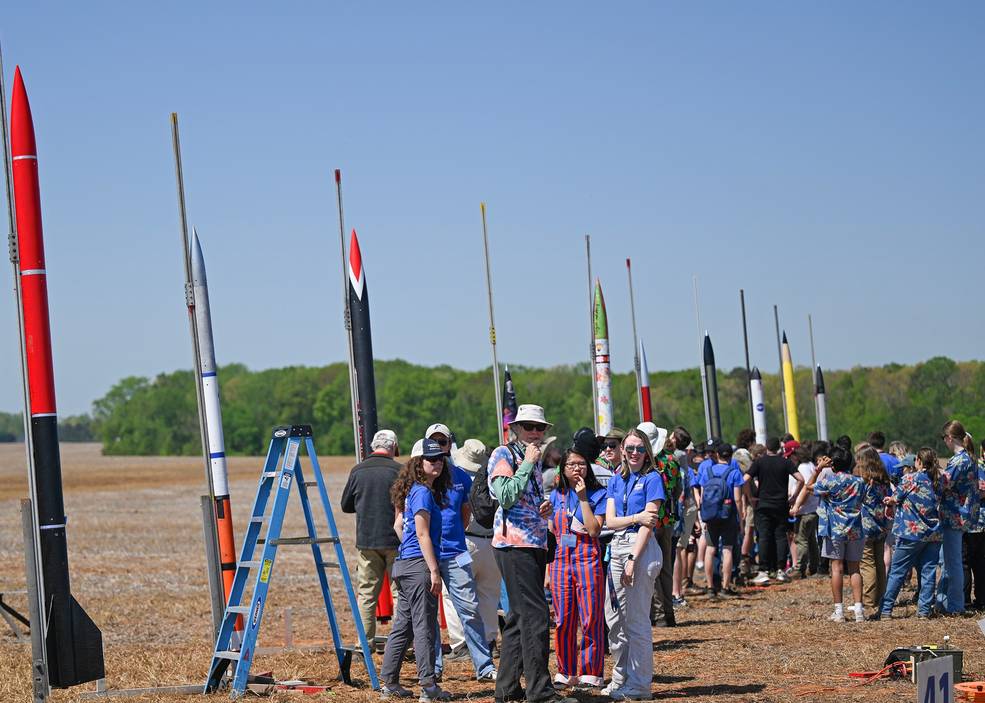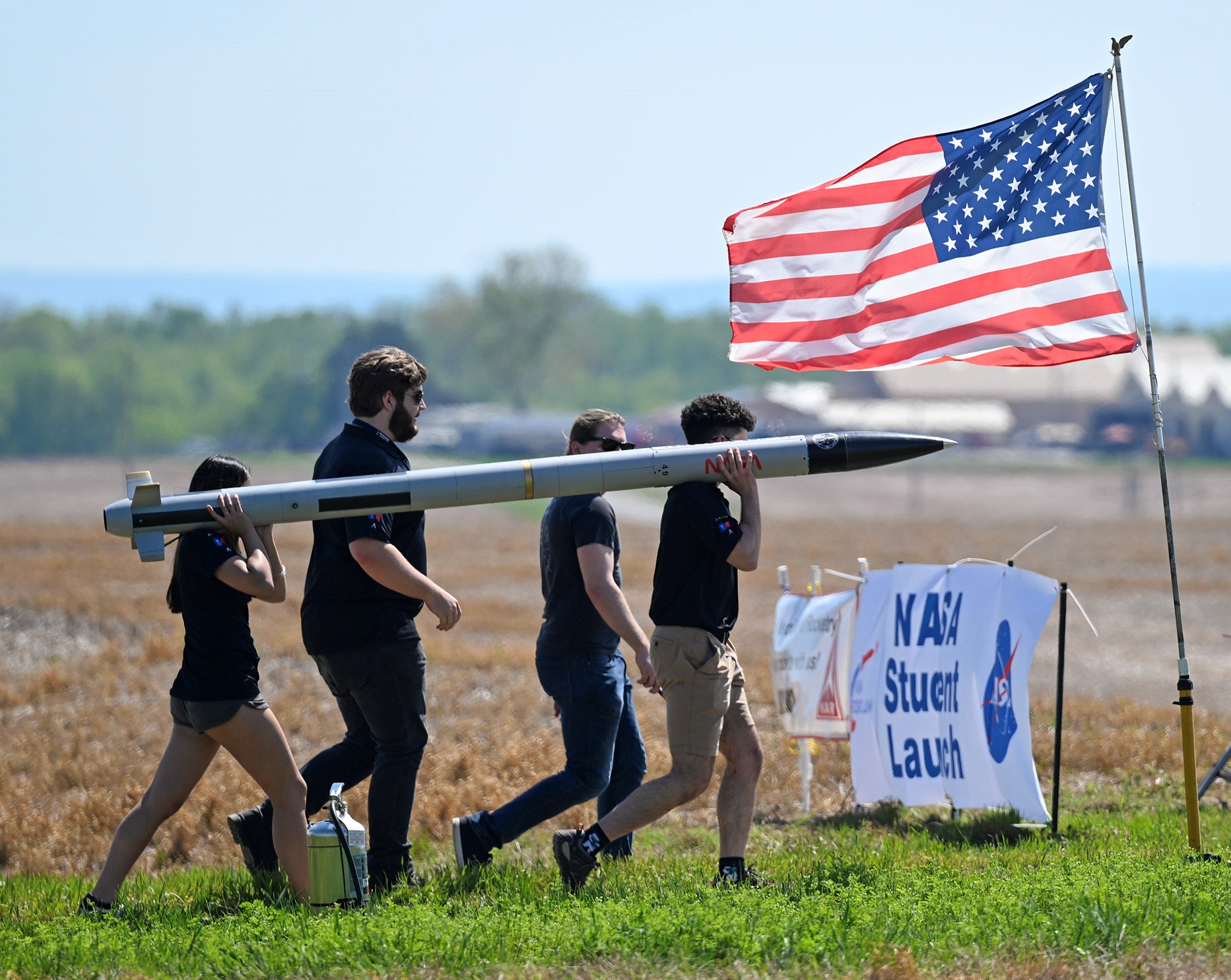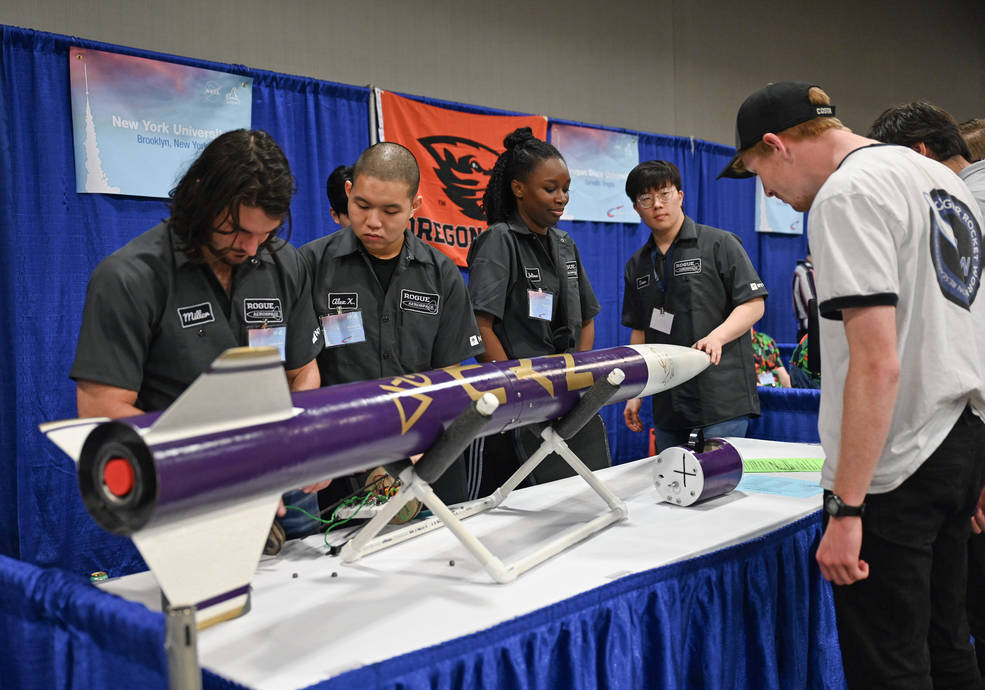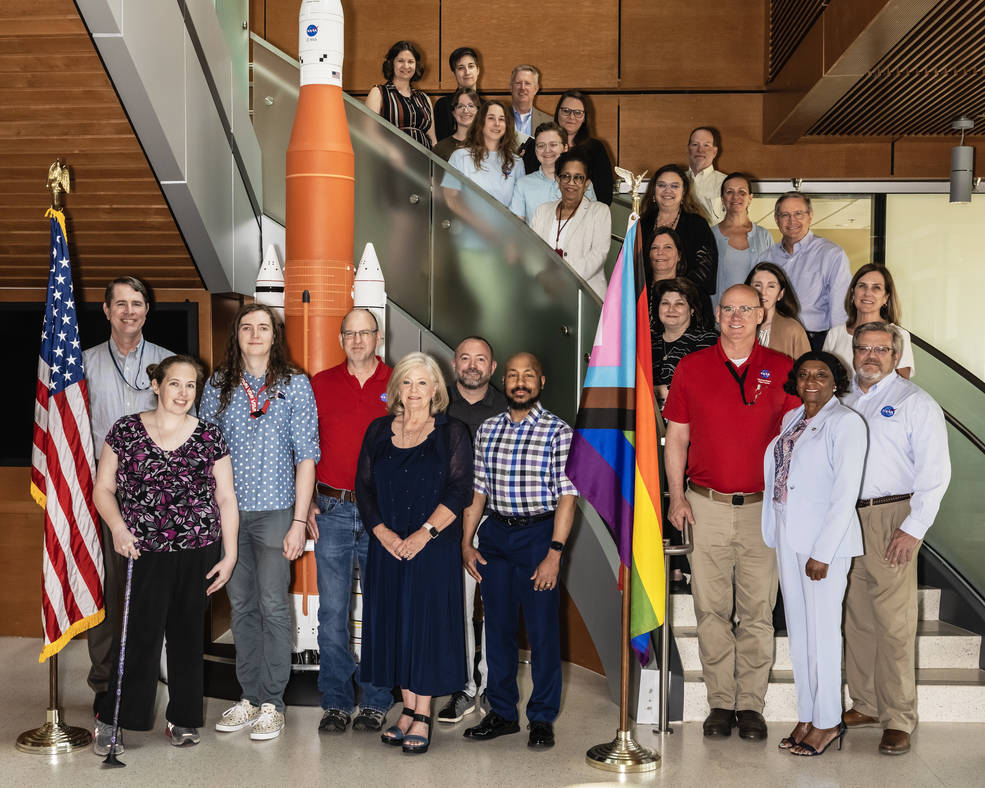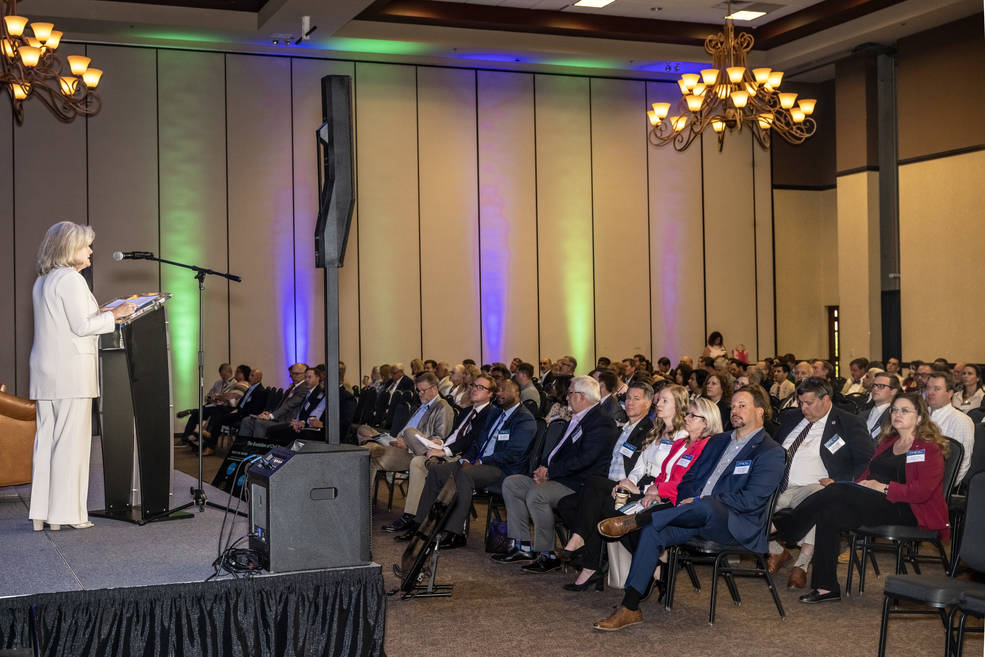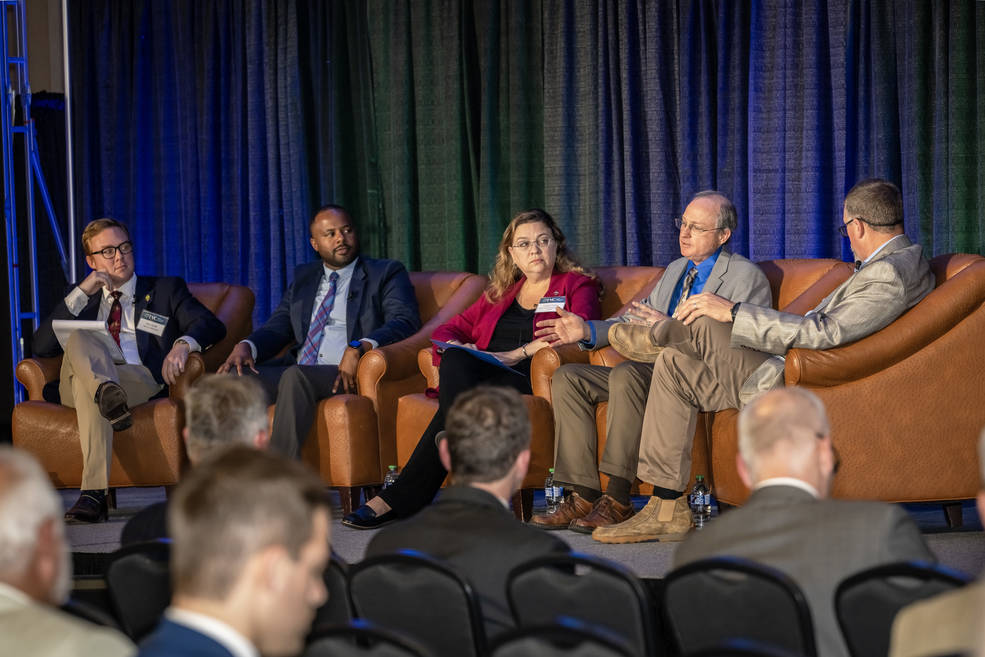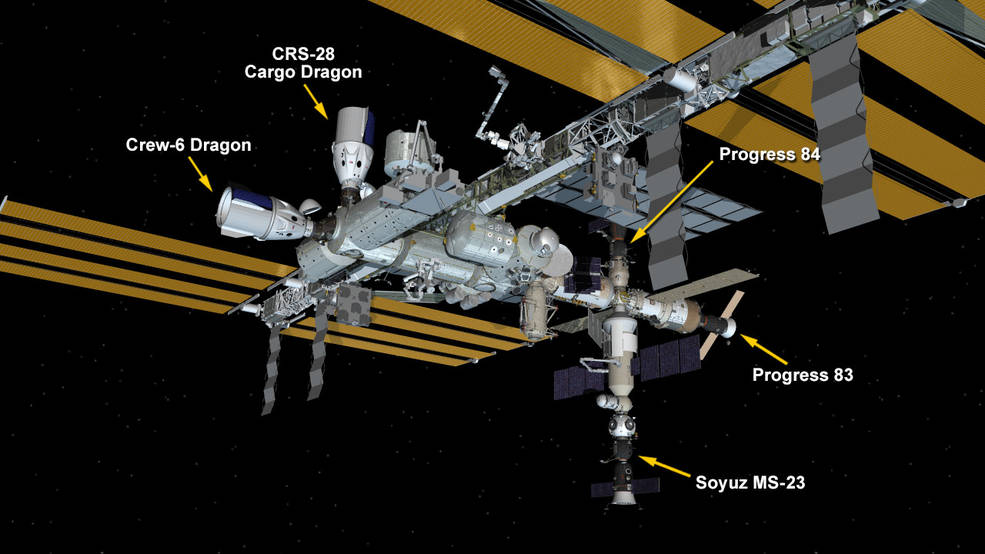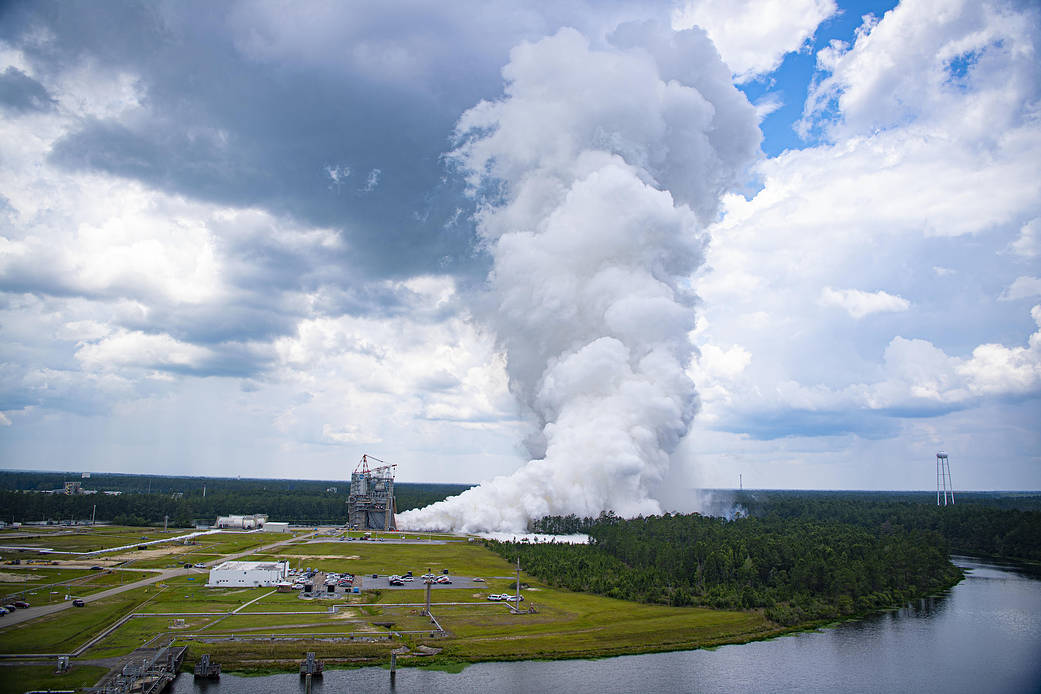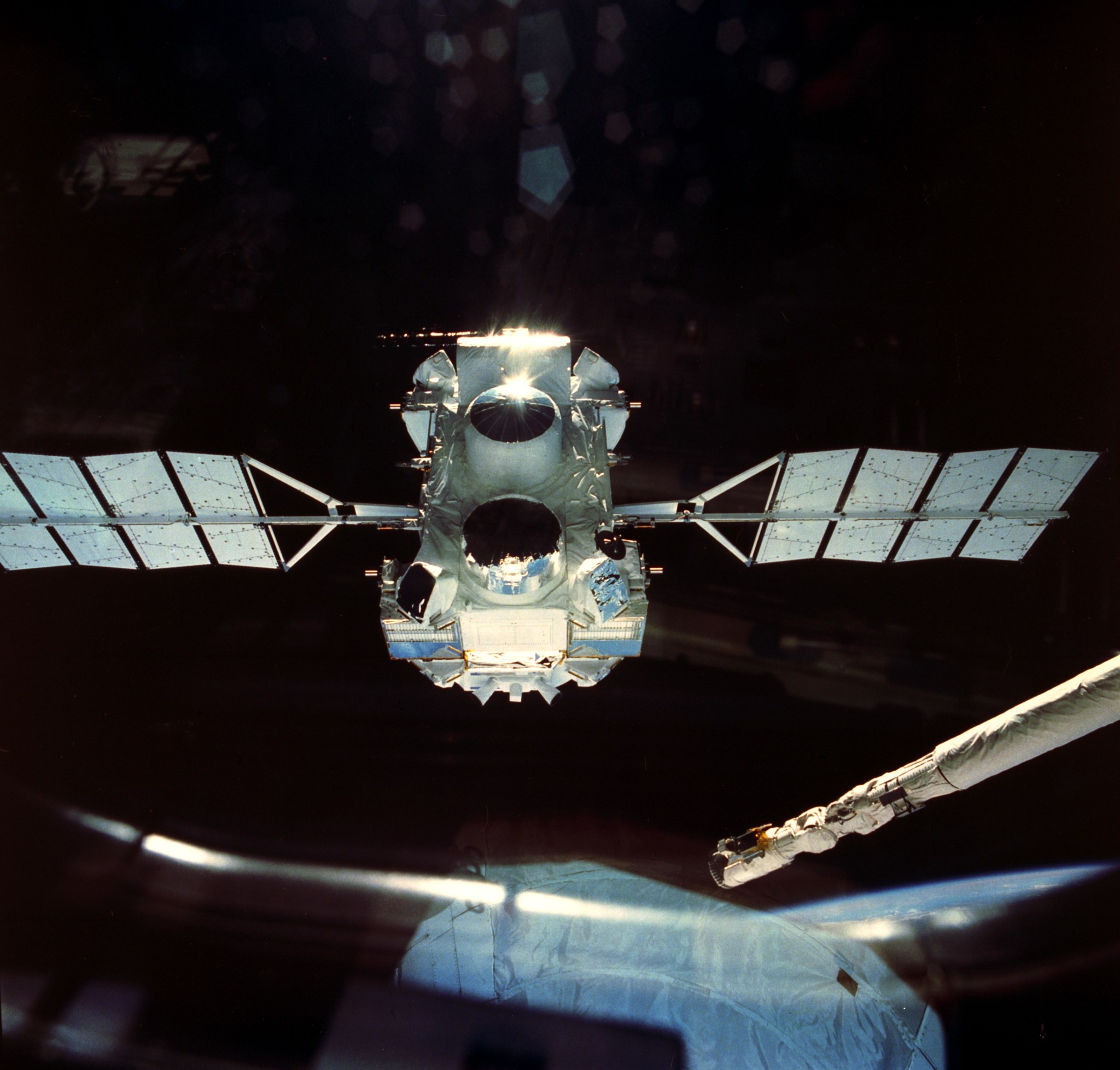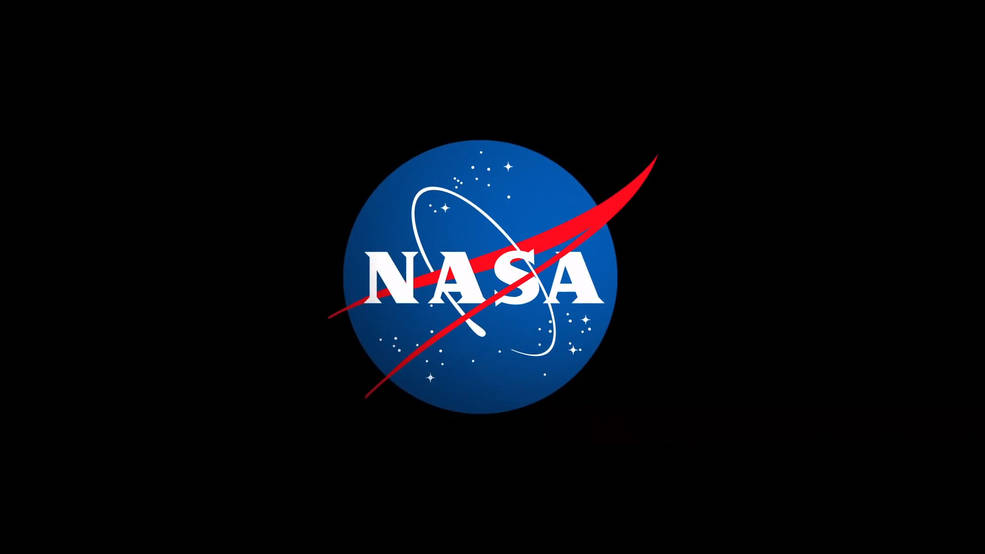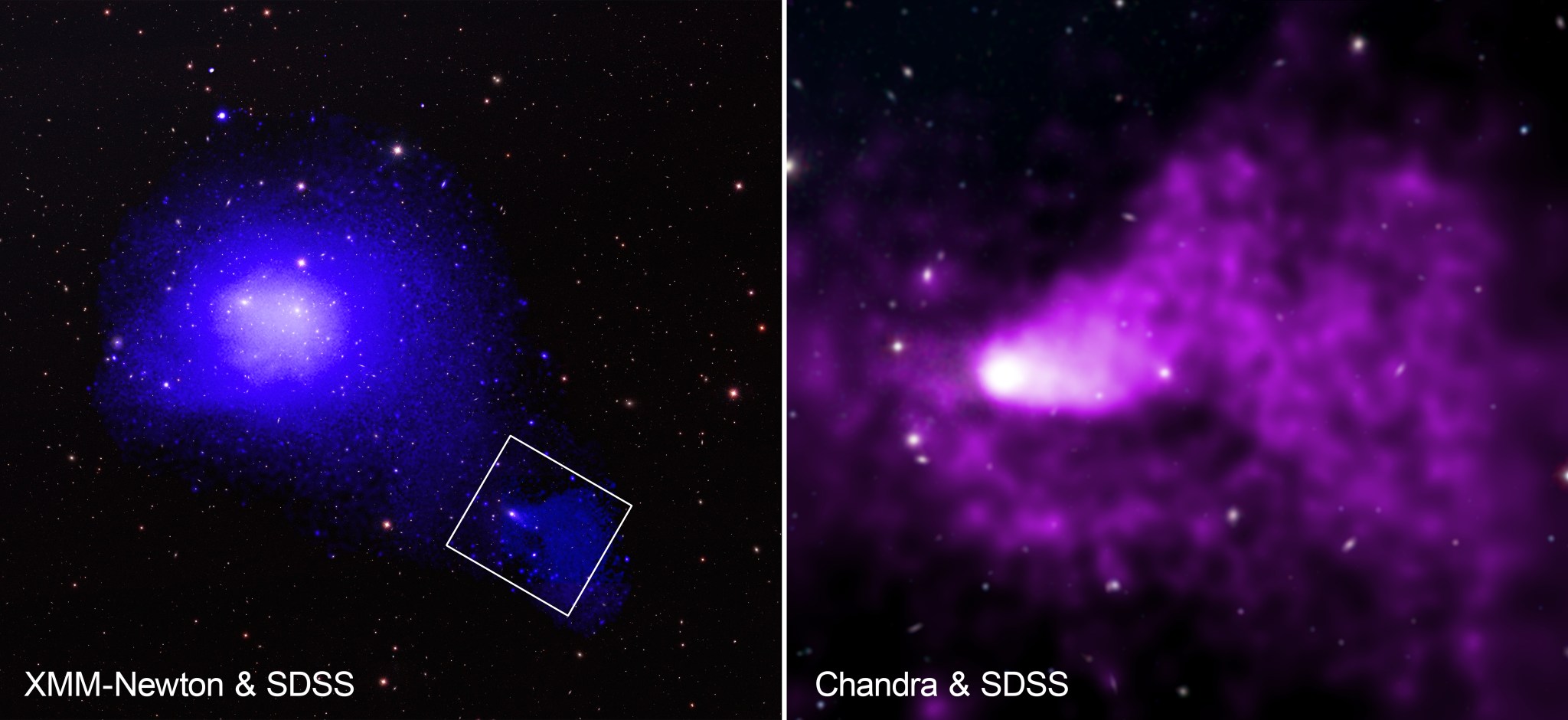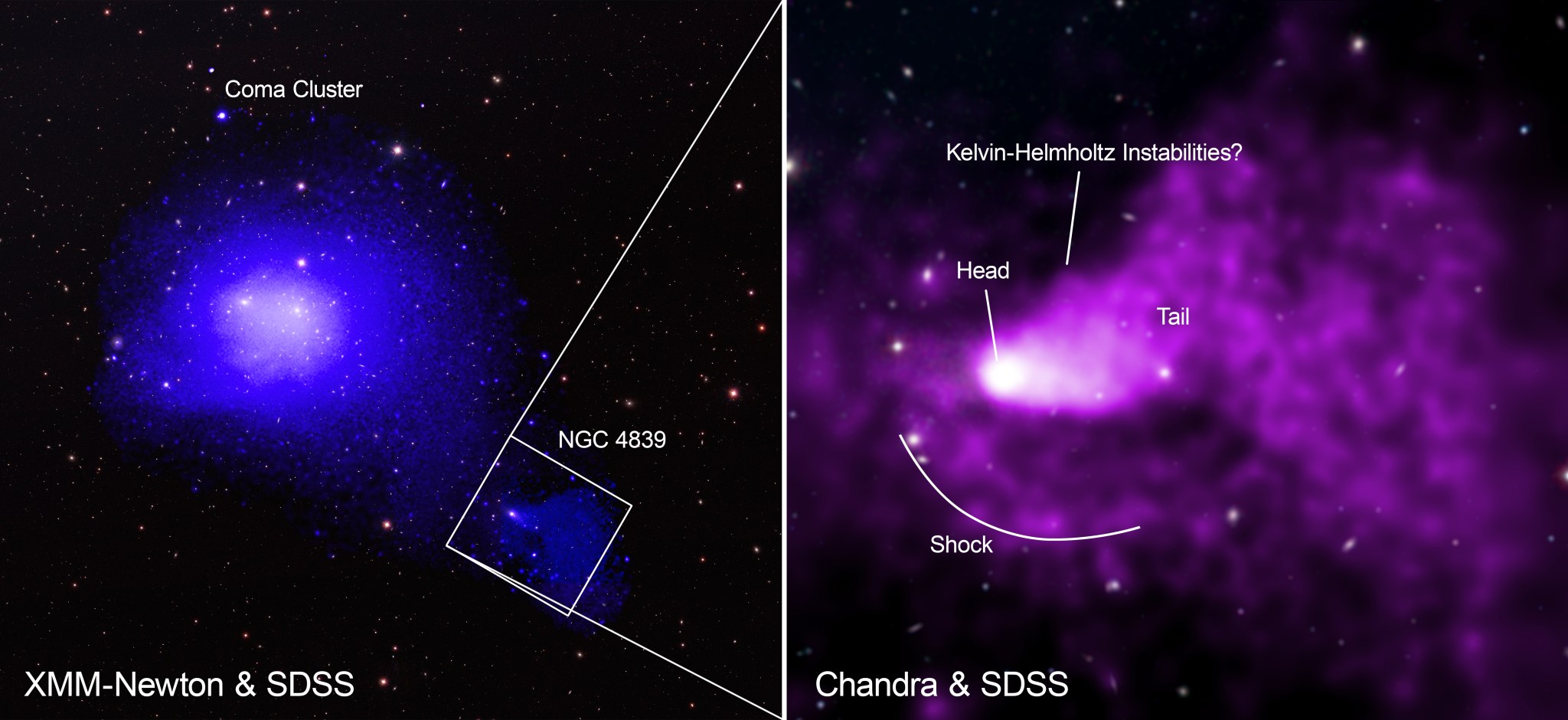The Marshall Star for June 7, 2023.
In This Week’s Star
- NASA Names Winners of 2023 Student Rocket Launch Competition
- Marshall Highlights Commitment to All Communities with Pride Flag Unveiling
- Marshall Leaders Participate in TVC National Summit
- Dragon Docks to Station, Delivers New Cargo and Solar Arrays
- NASA Enters Stretch in Critical Moon Rocket Engine Test Series
- NASA Looks Back at 50 Years of Gamma-Ray Burst Science
- U.S. Poet Laureate Ada Limón Unveils Poem for Europa Clipper
- NASA Awards Technical Workforce Training Contract
- Galaxies Go on Deep Dive, Leave Fiery Tail Behind
NASA Names Winners of 2023 Student Rocket Launch Competition
NASA announced June 6 the University of Alabama in Huntsville is the overall winner of the agency’s 2023 Student Launch challenge.
More than 800 students from across the U.S. and Puerto Rico launched high-powered, amateur rockets April 15, near NASA’s Marshall Space Flight Center as part of the culminating event for the agency’s annual Student Launch challenge.
For nine months prior, teams of middle school, high school, college, and university students were tasked to design, build, and launch a rocket and scientific payload to an altitude between 4,000 and 6,000 feet, while making a successful landing and executing a scientific or engineering payload mission.
“Our students share unique perspectives and design innovative technologies to address real-world difficulties of space exploration,” said Kevin McGhaw, director of NASA’s Office of STEM Engagement – Southeast Region. “As NASA celebrates its 23rd year of Student Launch, we are proud to help develop the next generation of skilled engineers and explorers capable of supporting NASA’s Artemis missions.”
The complete list of award winners are as follows:
2023 Overall Winners
- First place: University of Alabama in Huntsville
- Second place: University of North Carolina at Charlotte
- Third place: Vanderbilt University, Nashville, Tennessee
3D Printing Award:
College Level:
- First place: Iowa State University, Ames
Middle/High School Level:
- First place: East Aurora High School, East Aurora, New York
Altitude Award:
College Level:
- First place: Vanderbilt University, Nashville, Tennessee
- Second place: University of North Carolina at Charlotte
- Third place: University of Alabama in Huntsville
Middle/High School Level:
- First place: Spring Grove Area High School, Spring Grove, Pennsylvania
- Second place: Camas High School, Camas, Washington
- Third place: MATHmania Robotics, Mission Viejo, California
Best-Looking Rocket Award:
College Level:
- First place: North Carolina State University, Raleigh
- Second place: Virginia Polytechnic Institute and State University, Blacksburg
- Third place: Auburn University, Alabama
Middle/High School Level:
- First place: Cedar Falls High School, Cedar Falls, Iowa
- Second place: Yamhill Carlton High School, Yamhill, Oregon
- Third place: Boy Scouts Troop 17, Charlottesville, Virginia
American Institute of Aeronautics and Astronautics Reusable Launch Vehicle Innovative Payload Award:
College Level:
- First place: University of Alabama in Huntsville
- Second place: Washington University in St. Louis
- Third place: University of North Carolina at Charlotte
Judges’ Choice Award:
Middle/High School Level:
- First place: Cedar Falls High School, Cedar Falls, Iowa
- Second place: Seabrook Intermediate School, Seabrook, Texas
- Third place: MATHmania Robotics, Mission Viejo, California
Project Review Award:
College Level:
- First place: University of North Carolina at Charlotte
- Second place: Vanderbilt University, Nashville, Tennessee
- Third place: University of Notre Dame, Indiana
AIAA Reusable Launch Vehicle Award:
College Level:
- First place: New York University, New York
- Second place: Washington University in St. Louis
- Third place: University of Alabama in Huntsville
AIAA Rookie Award:
College Level:
- First place: United States Military Academy, West Point, New York
- Second place: Angelo State University, San Angelo, Texas
- Third place: University of Central Florida, Orlando
Safety Award:
College Level:
- First place: University of North Carolina at Charlotte
- Second place: University of Alabama in Huntsville
- Third place: University of Notre Dame, Indiana
Social Media Award:
College Level:
- First place: University of Puerto Rico, Mayaguez Campus
- Second place: North Carolina State University, Raleigh
- Third place: University of North Carolina at Charlotte
Middle/High School Level:
- First place: Morris County 4-H Rocketry Club, Morris County, New Jersey
- Second place: East Aurora High School, East Aurora, New York
- Third place: Boy Scouts Troop 17, Charlottesville, Virginia
STEM Engagement Award:
College Level:
- First place: Vanderbilt University, Nashville, Tennessee
- Second place: University of Notre Dame, Indiana
- Third place: University of Alabama in Huntsville
Middle/High School Level:
- First place: Cedar Falls High School, Cedar Falls, Iowa
- Second place: MATHmania Robotics, Mission Viejo, California
- Third place: Camas High School, Camas, Washington
Service Academy Award:
- First place: The U.S. Military Academy at West Point, New York
Vehicle Design Award:
Middle/High School Level:
- First place: Yamhill Carlton Rocketry, Yamhill, Oregon
- Second place: Spring Grove Area High School, Spring Grove, Pennsylvania
- Third place: Cedar Falls High School, Cedar Falls, Iowa
Payload Design Award:
Middle/High School Level:
- First place: Portland Rocketry, Portland, Oregon
- Second place: Yamhill Carlton Rocketry, Yamhill, Oregon
- Third place: Seabrook Intermediate School, Seabrook, Texas
Student Launch is one of NASA’s nine Artemis Student Challenges, activities which connect student ingenuity with NASA’s work returning to the Moon under Artemis in preparation for human exploration of Mars.
“Students are required to meet complex requirements and high expectations, literally,” said Fred Kepner, an education program specialist and activity lead for Student Launch at Marshall. “Student Launch is an authentic learning experience – one offering students experience working through the same processes NASA and our partners use for safety and quality control of space missions.”
Marshall hosts Student Launch with management support provided by NASA’s Office of STEM Engagement – Southeast Region. Funding is provided, in part, by NASA’s Space Operations Mission Directorate and NASA’s Next Gen STEM project. Additional support is provided by Northrup Grumman, National Space Club Huntsville, American Institute of Aeronautics and Astronautics, National Association of Rocketry, Relativity Space, Bastion Technologies, and Siemens Digital Industries Software.
Replays of this launch event and award ceremony are available on NASA’s Marshall YouTube and the Student Launch Facebook page.
Marshall Highlights Commitment to All Communities with Pride Flag Unveiling
NASA’s Marshall Space Flight Center Director Jody Singer and other senior leaders join members of Marshall’s LGBTQI+ employee resource group (ERG), Out & Allied, for a group photo with the Progress Pride Flag, currently on display in the lobby of Building 4221. Singer reiterated Marshall’s commitment to diversity and inclusion during the unveiling of the Progress Pride Flag, one of several ways Marshall team members and leaders are celebrating LGBTQI+ Pride Month. The center plans to display the flag throughout the month of June as a symbol of Marshall’s commitment to all communities, according to Singer. The flag features the six-colored rainbow used in the traditional Pride flag plus white, pink, and light blue to represent the trans community, and black and brown to represent LGBTQI+ communities of color. The black stripe also represents those living with HIV/AIDS and those who have lost their lives to the disease. In addition to the pride display, Out & Allied and Marshall’s Office of Diversity and Equal Opportunity have planned several events that employees can participate in to support LGBTQI+ team members, including a virtual-only June 29 Pride Month program featuring Jim Miller, retired middle school math teacher and longtime LGBTQI+ community advocate, as keynote speaker. Singer also said Marshall will soon cut the ribbon on a new ERG display in the lobby that will be used to highlight ERGs at the center, recognize team members’ contributions to NASA, and celebrate diversity year-round. (NASA/Mick Speer)
Marshall Leaders Participate in TVC National Summit
NASA’s Marshall Space Flight Center Director Jody Singer delivers the keynote address to a crowd of about 275 attendees during the opening session of the 2023 Tennessee Valley Corridor National Summit on May 31 at the Von Braun Center in Huntsville. Singer’s keynote was titled “Focusing on the Future: Science and Space.” Marshall’s Ginger Flores, manager of the Human Exploration Development & Operations Office, and Harold Gerrish, Marshall’s space nuclear propulsion senior technical leader, participated in the panel discussion for the session. The theme for this year’s summit was Focusing on the Future: National Leadership Through Regional Collaboration. (NASA/Mick Speer)
Flores, center, listens to a discussion on the significance of nuclear thermal propulsion during the panel discussion on the future of science and space in the Tennessee Valley Corridor. From left are, Ellis Smith, City of Chattanooga; Evann Freeman, EPB, located in Chattanooga; Flores; Gerrish; and Jeffrey Cornett, moderator, from Oak Ridge National Laboratory. Flores and Gerrish discussed Marshall priorities, including habitation systems, human landers, mission operations, and space nuclear propulsion. (NASA/Mick Speer)
Dragon Docks to Station, Delivers New Cargo and Solar Arrays
While the International Space Station was traveling approximately 270 miles over the coast of Brazil, a SpaceX Dragon cargo spacecraft autonomously docked to the station’s Harmony module at 4:54 a.m. CDT on June 6, with NASA astronaut Woody Hoburg monitoring operations.
The SpaceX Dragon launched as part of the company’s 28th commercial resupply services mission for NASA at 10:47 a.m. CDT, June 5, from Launch Complex 39A at the agency’s Kennedy Space Center. The Dragon will spend about three weeks attached to the space station before it returns to Earth with cargo and research.
The SpaceX Dragon has delivered a pair of IROSAs (International Space Station Roll Out Solar Arrays) that, once installed, will expand the energy-production capabilities of the microgravity complex.
Among the science experiments Dragon delivered to the space station are:
Thunderstorm Watch
What Happens Above Thunderstorms (Thor-Davis), an investigation from ESA (European Space Agency), observes thunderstorms from the space station. This vantage point allows researchers to see the electrical activity from above, particularly the inception, frequency, and altitude of recently discovered blue discharges. Scientists plan to estimate the energy of these phenomena to determine their effect on the atmosphere. A better understanding of lightning and electrical activity in Earth’s atmosphere could improve atmospheric models and provide a better understanding of Earth’s climate and weather.
Helping Plants Chill in Space
Plants exposed to environmental stress, including spaceflight, undergo changes to adapt, but those changes may not be passed on to the next generation. Plant Habitat-03 (PH-03) assesses whether plants grown in space can transfer such adaptations to the next generation and, if so, whether a change continues through subsequent generations or stabilizes.
The investigation creates a second generation of plants using seeds previously produced in space and returned to Earth. Results could provide insight into how to grow multiple generations of plants to provide food and other services on future space missions. This investigation also could support development of strategies for adapting crops and other economically important plants to marginal and reclaimed habitats on Earth.
Testing a Telomere Technique
Telomeres, genetic structures that protect our chromosomes, shorten with age and wear. But research has shown that telomeres lengthen in space. Genes in Space-10 tests a technique for measuring telomere length in microgravity, where methods typically employed on Earth are difficult to use due to gravity. The experiment explores whether telomere lengthening in space is caused by proliferation of stem cells – undifferentiated cells that give rise to specific body components and that typically have long telomeres.
Understanding the mechanism behind telomere lengthening could reveal possible effects on astronaut health during long-duration missions. Results also could lay the groundwork for a variety of related research to benefit future space travel and people on the ground.
Genes in Space is a national contest for students in grades 7 through 12 to design biotechnology experiments for space. The program is sponsored by miniPCR, Math for America, Boeing, New England Biolabs Ltd., and the ISS National Laboratory.
Thawing Ice, Solar Storms, and Attitude Recovery
Mission 26 for the station’s Nanoracks CubeSat Deployer (NRCSD) includes Educational Space Science and Engineering CubeSat Experiment Mission (ESSENCE), sponsored by the ISS National Laboratory and developed by universities in Canada and Australia. It carries a wide-angle camera to monitor thawing of ice and permafrost in the Canadian Arctic, which could provide a better understanding of the effects on Earth’s climate and support better local infrastructure planning.
The satellite also carries a solar energetic proton detector to collect data on periods of solar activity that emit highly energized radioactive protons that can damage the structure and electronic components of spacecraft. Understanding these effects could help make future CubeSats more resistant to radiation. In addition, the investigation demonstrates a novel method to recover control of a satellite’s attitude, or orientation, if a control mechanism fails. ESSENCE is part of the Canadian CubeSat Project, led by CSA (Canadian Space Agency).
Watching Cosmic Weathering
Iris, sponsored by the ISS National Laboratory, observes weathering of geological samples exposed to direct solar and background cosmic radiation and determines whether changes are visually detectable. The investigation also demonstrates experimental sun sensors, torque rods (which provide attitude control and detumbling for satellites), and a battery heater. A collaboration between graduate, undergraduate, and middle school students in Canada, the project provides hands-on experience that promotes interest in science, technology, engineering, and mathematics studies and careers.
These are just a few of the hundreds of investigations currently being conducted aboard the orbiting laboratory in the areas of biology and biotechnology, physical sciences, and Earth and space science. Advances in these areas will benefit life on Earth, help keep astronauts healthy during long-duration space travel, and demonstrate technologies for future human and robotic exploration beyond low Earth orbit to the Moon through NASA’s Artemis missions and eventually Mars.
NASA Enters Stretch in Critical Moon Rocket Engine Test Series
NASA entered the stretch run of a key RS-25 certification engine test series with a successful hot fire June 1, continuing to set the stage for future Artemis missions to the Moon. The hot fire on the Fred Haise Test Stand at NASA’s Stennis Space Center marked the ninth in a critical 12 test series. The remaining three tests are scheduled throughout June. The series is designed to certify production of new RS-25 engines by lead contractor Aerojet Rocketdyne for future SLS (Space Launch System) flights and deep space missions, beginning with Artemis V. Operators powered the RS-25 engine for more than eight minutes (500 seconds), the same amount of time needed to help launch the SLS rocket, carrying astronauts aboard the Orion spacecraft, into orbit. The engine also was fired up to 113% power, exceeding the 111% level needed during launch, to provide engineers with a margin of operational safety. The SLS rocket is powered, in part, by four RS-25 engines, firing simultaneously to produce as much as 2 million pounds of combined thrust. NASA launched the maiden Artemis I mission last November and is working toward future Artemis missions to return humans, including the first woman and first person of color, to the Moon. The agency will collaborate with commercial and international partners to build a long-term presence on the Moon as NASA prepares technologies and capabilities needed to send humans to Mars.NASA’s Marshall Space Flight Center manages the SLS Program. (NASA/Stennis)
NASA Looks Back at 50 Years of Gamma-Ray Burst Science
Fifty years ago, on June 1, 1973, astronomers around the world were introduced to a powerful and perplexing new phenomenon called GRBs (gamma-ray bursts). Today sensors on orbiting satellites like NASA’s Swift and Fermi missions detect a GRB somewhere in the sky about once a day on average. Astronomers think the bursts arise from catastrophic occurrences involving stars in distant galaxies, events thought to produce new black holes.
“I can still remember the excitement when gamma-ray bursts were discovered,” said Charles Meegan, a research scientist at the University of Alabama, Huntsville, who helped develop GRB detectors on NASA’s Compton and Fermi satellites. “I was a graduate student then, unaware that the study of these strange events would be my career for the next 50 years.”
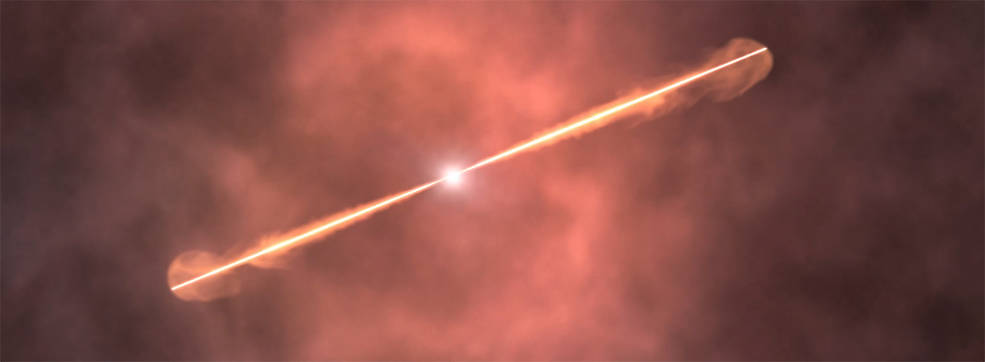
With GRBs, just about everything is extreme. They occur so far beyond our galaxy that even the closest-known burst exploded more than 100 million light-years away. Each burst produces an initial pulse of gamma rays, the highest-energy form of light, that typically lasts from milliseconds to minutes. This emission comes from a jet of particles moving close to the speed of light launched in our direction, and the closer we are to looking straight down the barrel, the brighter it appears. Following this prompt emission is a fading afterglow of gamma rays, X-rays, ultraviolet, visible, infrared, and radio light that astronomers may be able to track for hours to months.
Even half a century on, GRBs offer up surprises. One recent burst was so bright it temporarily blinded most of the gamma-ray detectors in space. Nicknamed the BOAT (for brightest of all time), the 7-minute blast may have been the brightest GRB in the past 10,000 years. It also showed that scientists’ most promising models of these events are nowhere near complete.
The GRB story begins in October 1963, when a treaty signed by the United States, the United Kingdom, and the Soviet Union prohibiting the testing of nuclear weapons in the atmosphere, under water, or in space went into effect. To ensure compliance, the U.S. Air Force had been managing an unclassified research and development effort to detect nuclear tests from space. A week after the treaty went into effect, the first two of these satellites, called Vela (from the Spanish “to watch”), began their work.
Launched in pairs, the Vela satellites carried detectors designed to sense the initial flash of X-rays and gamma rays from nuclear explosions. Sometimes they triggered on events that clearly were not nuclear tests, and scientists collected and studied these observations. With improved instruments on the four Vela 5 and 6 satellites, Ray Klebesadel at Los Alamos National Laboratory in New Mexico, together with his colleagues Ian Strong and Roy Olsen, determined directions to 16 confirmed gamma-ray events well enough to rule out Earth and the Sun as sources. They published a paper announcing the discovery in The Astrophysical Journal on June 1, 1973.
Using a detector aboard the IMP 6 satellite intended to study solar flares, Tom Cline and Upendra Desai at NASA’s Goddard Space Flight Center quickly confirmed the Vela findings.
While theorists proposed 100 models in an effort to explain GRBs – most involving neutron stars in our own galaxy – observational progress was slow despite the growing number of detections by different spacecraft. Gamma rays can’t be focused like visible light or X-rays, making precise localizations quite difficult. Without them, it was impossible to search for GRB counterparts in other wavelengths using larger telescopes in space or on the ground.
In 1991, NASA launched the Compton Gamma Ray Observatory, which included an instrument named BATSE (Burst and Transient Science Experiment) dedicated to exploring GRBs. Developed at NASA’s Marshall Space Flight Center by a team that included Meegan, BATSE was about 10 times more sensitive than previous GRB detectors. Over Compton’s nine-year mission, BATSE detected 2,704 bursts, which gave astronomers a rich set of observations made with the same instrument.
In its first year, BATSE data showed that bursts were distributed all over the sky instead of in a pattern that reflected the structure of our Milky Way galaxy. “This suggested that they were coming from distant galaxies, and that meant they were more energetic than most scientists thought possible,” Meegan said.
Around the same time, Chryssa Kouveliotou, another member of the BATSE team, led an effort to classify the bursts. The team found that burst durations clustered into two broad groups – one lasting less than two seconds, the other lasting longer than two seconds – and that short bursts produced higher-energy gamma rays than long ones.
“So both temporal and spectral properties agreed in identifying two separate groups of GRBs: short and long,” said Kouveliotou, who now chairs the department of physics at George Washington University. “Soon after, theorists associated long GRBs with the collapse of massive stars and short ones with binary neutron star mergers.”
The next step in understanding came with watershed observations from the Italian-Dutch satellite BeppoSAX. Although not specifically designed as a GRB mission, its mix of instruments – including a gamma-ray monitor and two wide-field X-ray cameras – proved a boon to the field.
When a burst occurred in the field of view of one of the X-ray cameras, the spacecraft could locate it well enough over a couple of hours that additional instruments could be brought to bear. Whenever BeppoSAX turned to a GRB’s position, its instruments found a rapidly fading and previously unknown high-energy source – the X-ray afterglow theorists had predicted. These positions enabled large ground-based observatories to discover long GRB afterglows in visible light and radio waves, and also permitted the first distance measurements, confirming that GRBs were truly far-away events.
In 2000, NASA launched HETE 2, a small satellite designed to detect and localize GRBs. It was the first mission to compute accurate positions onboard and quickly – in tens of seconds – communicate them to the ground so other observatories could study early afterglow phases. The burst it discovered on March 29, 2003, also exhibited definitive supernova characteristics, confirming a suspected relationship between the two phenomena.
What took BeppoSAX a couple of hours, NASA’s Neil Gehrels Swift Observatory, launched in 2004, can do in about a minute. “We named it Swift for a reason,” said Goddard’s S. Bradley Cenko, the mission’s current principal investigator. “Its rapid, automated response allowed us to detect flares and other features in X-ray afterglows not previously seen.”
Following up on GRBs detected by these missions confirmed that long bursts were associated with the star-forming regions of galaxies and were often accompanied by supernovae. In May 2005, Swift was able to pinpoint the first afterglow of a short GRB, showing that these blasts occur in regions with little star formation. This bolstered the model of short bursts as mergers of neutron stars, which can travel far from their birth place over the many millions of years it takes for them to crash together.
In 2008, NASA’s Fermi Gamma-ray Space Telescope joined Swift in hunting GRBs and has observed about 3,500 to date. Its GBM (Gamma-ray Burst Monitor) and Large Area Telescope allow the detection and follow-up of bursts from X-rays to the highest-energy gamma rays detected in space – an energy span of 100 million times. This has enabled the discovery of afterglow gamma rays with billions of times the energy of visible light.
In 2017, Fermi and the European INTEGRAL satellite linked a short GRB to a source of gravitational waves, ripples in space-time produced as orbiting neutron stars spiraled inward and merged. This was an important first that connected two different cosmic “messengers,” gravity and light. While astronomers haven’t seen another “gravity and light” burst since, they hope more will turn up in current and future observing runs of gravitational wave observatories.
“We’re building new satellites with greater sensitivity to delve more deeply into this phenomenon, so the future of GRB science is bright,” said Marshall’s Dan Kocevski, a member of the Fermi GBM team and the principal investigator for StarBurst, a small satellite designed to explore GRBs from neutron star mergers. Other missions include Glowbug, part of an experiment package launched to the International Space Station in March and led by J. Eric Grove at the U.S. Naval Research Laboratory in Washington; BurstCube, led by Goddard’s Jeremy Perkins and slated for launch in early 2024; MoonBEAM, which would orbit between Earth and the Moon and is led by Marshall’s Chiumun Michelle Hui; and LEAP, designed to study GRB jets from the space station, led by Mark McConnell at the University of New Hampshire, Durham.
And as gravitational and gamma-ray facilities both improve their reach, a new chapter of the GRB story will open.
“What will completely revolutionize our understanding of GRBs,” said Alessandra Corsi, an associate professor at Texas Tech University in Lubbock, “will be the ability to track them back to when the universe was most intensely forming stars, around 10 billion years ago. This part of the universe will be probed by the next generation of gravitational wave detectors – 10 times more sensitive than what we currently have – and by future gamma-ray missions that can ensure continuity with the fantastic science Swift and Fermi have enabled.”
U.S. Poet Laureate Ada Limón Unveils Poem for Europa Clipper
U.S. Poet Laureate Ada Limón reads her poem for the Europa Clipper mission during an event with NASA on June 1 at the Library of Congress in Washington. The original poem, entitled “In Praise of Mystery: A Poem for Europa,” connects two water worlds – Earth and Europa. The poem will be engraved on a plaque carried aboard the Europa Clipper spacecraft as part of NASA’s “Message in a Bottle” campaign, which invites people around the world to sign their names to the poem that will journey to another world. Participants’ names will travel 1.8 billion miles aboard the Europa Clipper spacecraft, set to launch in October 2024, on its voyage to Jupiter and its moons. Managed by Caltech in Pasadena, California, NASA’s Jet Propulsion Laboratory (JPL) leads the development of the Europa Clipper mission in partnership with the Johns Hopkins Applied Physics Laboratory (APL) in Laurel, Maryland, for NASA’s Science Mission Directorate. APL designed the main spacecraft body in collaboration with JPL and NASA’s Goddard Space Flight Center. The Planetary Missions Program Office at NASA’s Marshall Space Flight Center executes program management of the Europa Clipper mission. Learn more about Europa Clipper. (NASA/Keegan Barber)
NASA Awards Technical Workforce Training Contract
NASA has selected Osi Vision LLC of San Antonio to provide program support and course development/delivery for NASA’s Academy of Program/Project & Engineering Leadership Knowledge Services (APPEL KS) activities for the Agency.
The Technical Workforce Education and Expertise Development Services (TWEEDS) contract is a hybrid cost-plus fixed fee/firm fixed price/cost-reimbursement contract with a value of approximately $60 million.
The performance period began June 2 and includes a phase-in period not to exceed 60 days; a base period of one-year; four one-year option periods; and one six-month option.
TWEEDS will provide support services and analysis across a wide range of activities to support NASA mission success. Some of these include: executive management, web-based tool and data collection, APPEL KS course development and delivery and logistics support for all course attendees, knowledge events and panels, strategic communications support including website, social media, and podcast development and management, webinars, event software management, support for specific financial management tasks, and configuration management services to meet the needs of the agency’s practitioners and the overall mission of NASA.
Galaxies Go on Deep Dive, Leave Fiery Tail Behind
A group of galaxies is plunging into the Coma galaxy cluster and leaving behind an enormous tail of superheated gas. Astronomers have confirmed this is the longest known tail behind a galaxy group and used it to gain a deeper understanding of how galaxy clusters – some of the largest structures in the universe – grow to their enormous sizes.
Astronomers trained NASA’s Chandra X-ray Observatory on the galaxy group NGC 4839. Galaxy groups are collections of about 50 galaxies or less that are bound together by gravity. Galaxy clusters are even larger and can contain hundreds or thousands of individual galaxies.
Both galaxy clusters and galaxy groups are enveloped by huge amounts of hot gas that are best studied using X-rays. These superheated pools of gas, though extremely thin and diffuse, represent a significant portion of the mass in galaxy groups or clusters and are crucial for understanding these systems.
NGC 4839 is located near the edge of the Coma galaxy cluster, one of the largest known clusters in the universe about 340 million light-years away. As NGC 4839 moves toward the center of the Coma cluster, the hot gas in the galaxy group is stripped away by its collision with gas in the cluster. This results in a tail forming behind the galaxy group.
The image on the left shows an X-ray view of the Coma galaxy cluster taken with ESA’s (European Space Agency’s) XMM-Newton (blue), along with optical data from the Sloan Digital Sky Survey (yellow). The galaxy group NGC 4839 is located in the lower right of that image. The inset on the right is the Chandra image (purple) of the region outlined by the square. The head of NGC 4839’s tail is on the left side of the Chandra image and contains the brightest galaxy in the group and the densest gas. The tail trails to the right. (The Chandra image has been rotated so that north is about 30 degrees to the left of vertical.)
X-rays from the hot gas in the outer regions of the Coma cluster – that NGC 4839 is traveling through – are too faint to be seen in the XMM image shown here, but are highlighted in a supplementary, XMM-only image. This mosaic of images shows gaps between individual images where data was not obtained, and dark holes where point sources of X-rays were removed.
This tail is, in fact, 1.5 million light-years long, or hundreds of thousands of times the distance between the Sun and the nearest star, making it the longest tail ever seen trailing behind a group of galaxies.
The current brightness of the tail gives astronomers a special chance to study the physics of the tail’s gas before it mixes in with the hot gas in the cluster and becomes too faint to study. The gas in the tail behind NGC 4839 will ultimately merge with the large amount of hot gas already present in the Coma Cluster.
Using the Chandra data to analyze the gas in front of the galaxy group, the researchers found a shock wave – similar to a sonic boom from a supersonic jet – showing that NGC 4839 is traveling at about 3 million miles per hour through the galaxy cluster. The shock wave’s location is highlighted in a labeled version of the image.
They also studied the amount of turbulence in the tail’s gas. For a familiar analogy, turbulence describes the irregular air movements in our atmosphere that can make for bumpy rides on airplanes. They found a mild amount of turbulence, which implies that heat conduction in NGC 4839 is low.
The team also saw possible evidence for special structures called Kelvin-Helmholtz instabilities on one side of the tail. Scientists find these structures in various settings in space and on Earth, including in cloud shapes. They are caused by differences in speed of adjacent layers of moving gas or fluid. The presence of Kelvin-Helmholtz instabilities in NGC 4839 suggest that the gas in the tail has a weak magnetic field or a low level of viscosity. (Water, for example, is less viscous than honey.) The locations of the Kelvin-Helmholtz instabilities are given in a labeled Chandra image and a version of the Chandra image that has been processed to emphasize regions in the image with sharper edges.
Researchers looking at earlier observations of NGC 4839 had estimated its tail to be at least one million light-years long. The new Chandra data reveals the new record-holding 1.5 million light-years length. (Tails behind three other groups of galaxies falling into galaxy clusters are between 800,000 and one million light-years long.)
Stephen Walker of the University of Alabama at Huntsville presented these results at the 242nd meeting of the American Astronomical Society in Albuquerque, New Mexico. These results also appear in a paper by Mohammad Mirakhor, Walker, and James Runge in the June issue of the Monthly Notices of the Royal Astronomical Society. Mirakhor and Runge are also from the University of Alabama at Huntsville. The paper is available online at https://arxiv.org/abs/2304.05419.
NASA’s Marshall Space Flight Center manages the Chandra program. The Smithsonian Astrophysical Observatory’s Chandra X-ray Center controls science operations from Cambridge, Massachusetts, and flight operations from Burlington, Massachusetts.


























